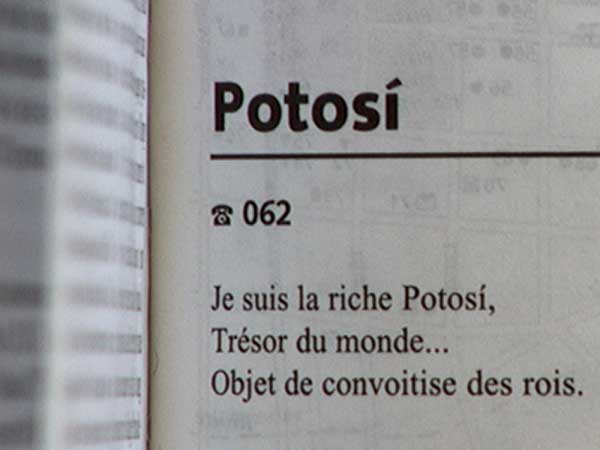
long à télécharger entièrement, fonctionne
avec du son / length to be entirely downloaded, works with sound
| |
|
 |
|
|
long à télécharger entièrement, fonctionne
avec du son / length to be entirely downloaded, works with sound
|
|
< retour / back
----------- >english below<
Le Cerro Rico (ou Sumaj Orcko en quechua, ce qui signifie la plus belle montagne) est le symbole de l'exploitation de l'Amérique du Sud par les Européens. En effet, cette montagne de plus de 4920 mètres fut exploitée pendant III siècles par les espagnols qui y ont découvert un gisement d'argent colossal. Cette exploitation forcenée a coûté la vie à 8 millions d'indiens et d'esclaves noirs sacrifiés, au rythme de 50 000 par an, pour en extraire ses richesses.
La montagne, pendant cette même période, a perdu plus de 200 mètres de déniveler à cause des excavations.
La ville de Potosí, qui se trouve au pied du Cerro Rico, fut élevée au rang de ville impériale par Charles Quint en 1546, ce fut l’unique ville d´Amérique Latine qui bénéficia de cette distinction. L'endroit était considéré au XVIème siècle comme le plus grand complexe industriel du monde. Au début du XVIIème siècle, Potosi était la seconde ville d’occident avec ses 160 000 habitants, devant Londres et Paris. En 1987, Potosi fut déclaré patrimoine mondial de l'humanité par l’UNESCO.
Aujourd'hui, la vie dans cette ville d'altitude (4100 mètres) est bien difficile, les riches filons d'argent sont épuisés depuis longtemps. Les mineurs y travaillent encore afin d’extraire le plomb et l’étain avec des méthodes archaïques, ou se transforment en guide pour touristes occidentaux...
English (automatic translation)-----------
Cerro Rico (or Sumaj Orcko in quechua, which means the most beautiful mountain) is the symbol of the exploitation of South America by Europeans. Indeed, this mountain of more than 4920 meters was exploited during III centuries by the Spaniards who discovered a colossal silver layer there. This exaggerated exploitation cost the life of 8 million Indians and black slave sacrificed to the rate of 50 000 by year to extract its richnesses. The mountain, for this same period, lost more than 200 meters of uneven because of the excavations.
The town of Potosí, which is with at the foot of Cerro Rico, was high with the row of imperial city by Charles Quint in 1546, it was the unic town of Latin America which profited from this distinction. The place was considered in XVIème century, the greatest industrial complex of the world. At the beginning of the XVIIème century, Potosi was the second city from the occident with its 160 000 inhabitants, in front of London and Paris.
In 1987, Potosi was declared world heritage and humanity by UNESCO.
Today, the life in this town of altitude (4100m) is quite difficult, the silver mines are exhausted for a long time. The minors there still working to extract lead and tin with antiquated methods, or transforming themselves into guide for Western tourists...
The artists profited from the admission free to the museum of the Louvre as of its opening en1793. If this exemption from payment knew interruptions, it had been restored for several decades. The exemption from payment, fortunately, was preserved for fragile people the "socially", students, unemployed, rmists. However, the economic brittleness of the sector of the visual arts, the precarious situation of the artists, the frees-lance of national education and the freelance journalists of the press are a manifestly recognized reality. The purpose of this gathering was to require that all the public ones find the free access to the permanent collections each Sunday.
The Louvre largely uses its tarif autonomy to follow a policy more and more mercantile. In February 2004, the entrance fee increased by 13% - what does of the Louvre one of the most expensive museums in the world...